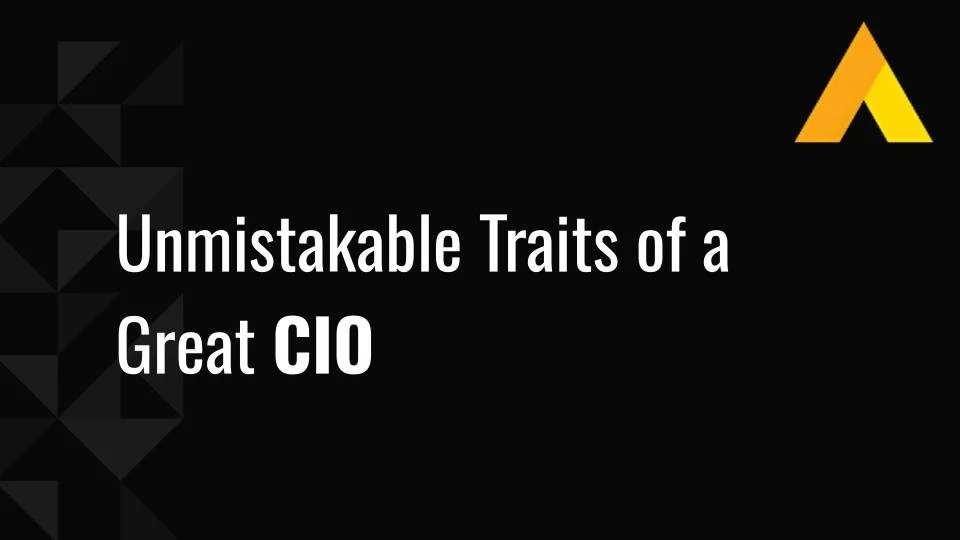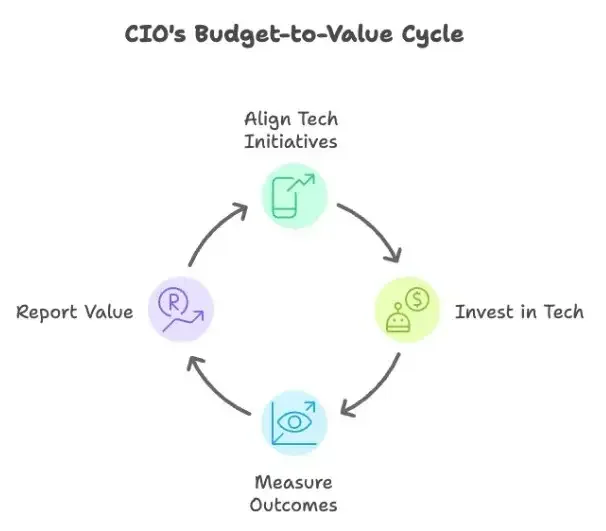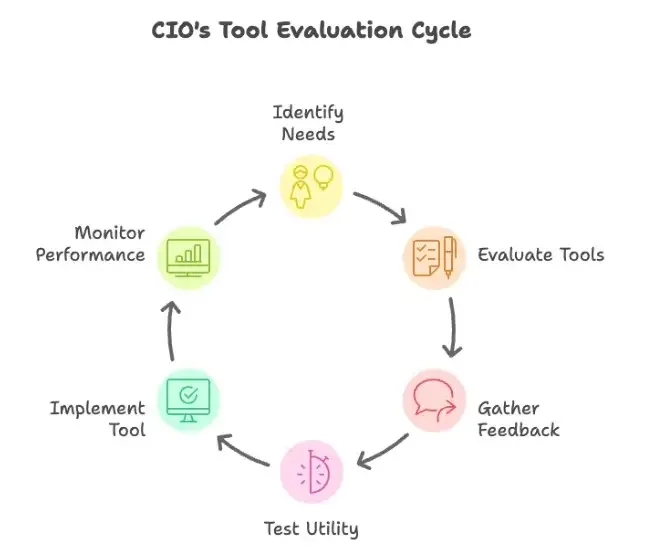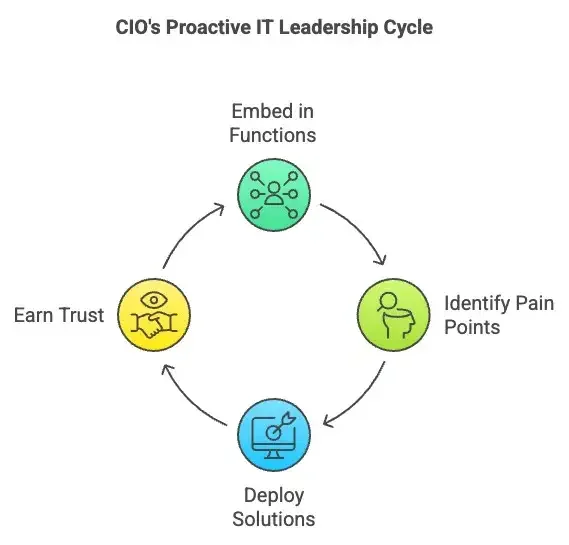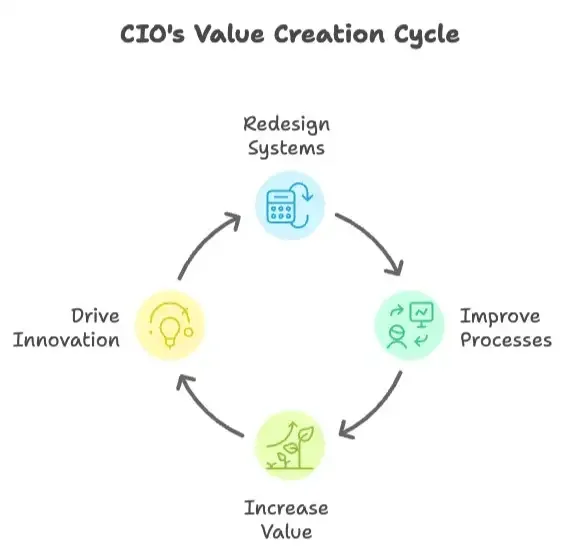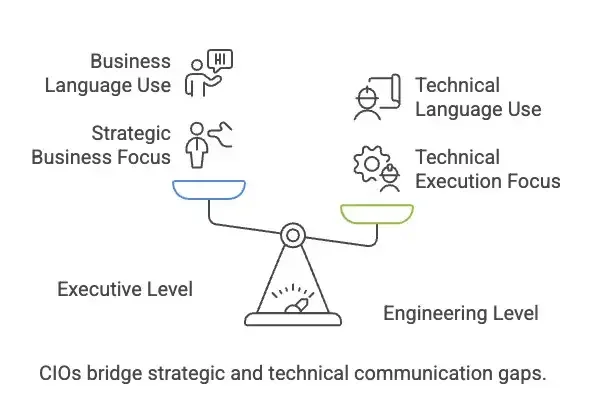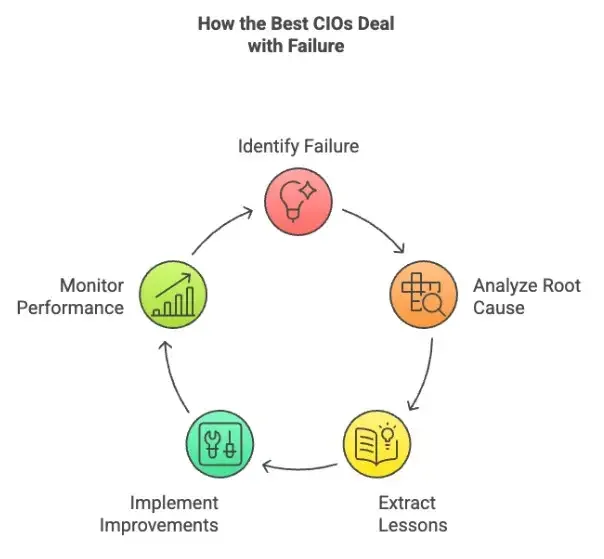10 Unmistakable Traits Of A Great CIO
You don’t need to be a coding genius to become a great CIO. That’s a myth. The best Chief Information Officers today aren’t simply tech wizards; they’re agile business architects who link digital technology with business objectives.
They translate a bold vision into reality while guiding the leadership team through organizational transformation. In tech vanguard organizations, the CIO often plays a more pivotal role than the CEO.
This article breaks down the ten unmistakable traits that define the ideal technology leader and why they matter more than ever in a world shaped by disruptive technologies and rapid business disruption.
Why Does a Great CIO Matter?
They drive tech-enabled business transformation: A great CIO makes sure your digital technology isn’t just running in the background; it’s growing the business.
They align IT with business strategy: Good CIOs translate business objectives into a clear technology strategy that supports growth orientation.
They influence the leadership team: In many organizations, CIOs shape high-level decisions alongside other C-suite leaders, including the CEO.
They manage technology budgets wisely: The approach to technology investments directly impacts innovation initiatives and business model evolution.
They lead through disruption: With advanced technologies and Agile development initiatives constantly shifting the market, the CIO plays a key role in adapting fast.
They create better customer experiences: A CIO’s approach to collaboration methods and platforms can directly affect customer service outcomes.
They future-proof the company: The ideal technology leader understands that future technology leaders must be ready for constant change and business disruption.
They build a kinetic leadership culture: Great CIOs promote agile delivery and bold vision while bringing up emotional capabilities across teams.
What are the Key Responsibilities and Duties of a CIO?
Set and execute the technology strategy: A CIO defines the approach to tech strategy so it supports the broader approach to business strategy and aligns with the company’s appetite for growth.
Oversee core technology functions: This includes everything from infrastructure to security to Agile software delivery, and making sure these systems evolve as needed.
Lead organizational transformation: A CIO often drives innovation initiatives and Agile initiatives that support digital officer roles and business model shifts.
Bridge tech and business: They act as a translator between tech vanguards and business leaders to make sure the technology function maturity matches business objectives.
Control and optimize technology budgets: Great CIOs balance cost efficiency with advanced technologies and an orientation toward growth.
Enable collaboration across teams: From deciding on the right collaboration tool to shaping collaboration methods, they set the tone for how departments work together.
Contribute to strategic vision: They play an active role in the leadership team, offering advice to boards, holding board positions, and turning a bold vision into reality.
Monitor and apply Tech Trends: They follow tech trends to guide decisions and keep the organization future-ready, especially in tech vanguard organizations or top technology firms.
10 Unmistakable Traits Of A Great CIO
So what does a truly great CIO look like? There are many possible options, but let’s break down some of the common key traits excellent CIOs tend to share.
1. They Treat the CRM Like a Power Tool, Not a Filing Cabinet
Too many companies treat their CRM like a digital storage room: a passive place where data is dumped but never activated. Great CIOs reject this completely. Instead, they treat the CRM as a collaboration tool that drives real-time value for sales and service teams.
They configure data flows to serve customer conversations, not just dashboards. For instance, a CIO might integrate CRM with marketing automation and customer service platforms so reps can view full-funnel activity in one place, which gives them better context when closing deals or handling objections.
The graphic below shows the power of a properly-used CRM:
The numbers support this approach. According to Salesforce, CRM systems can increase sales by up to 29%, sales productivity by 34%, and forecast accuracy by 42%, but only when they’re optimized for usability and accessibility across functions. These gains are not automatic; they come from CIOs who obsess over user experience, streamline integrations, and drive front-line adoption.
2. They Translate Technology Budgets Into Sales Pipeline Value
A high-performing CIO will map every dollar to pipeline outcomes. That means aligning tech initiatives like Agile software delivery or customer-facing tool investments directly with measurable sales KPIs. In practice, this could look like funding a machine-learning model that prioritizes lead scoring, or rolling out a new quoting tool that cuts deal cycle time. The CIO’s real value shows when they can explain to the CFO how a $2M investment in automation led to $8M in incremental pipeline and faster revenue realization.
IT leaders who align technology budgets with business goals are more likely to be high performers compared to those who focus only on cost control. CIOs need to reframe their approach to technology investments from a cost center to a sales enablement engine.
Here’s how CIOs turn budget into real value:
Even more striking, McKinsey reports that companies using enterprise agility saw 20–30% increases in financial performance and 30–50% improvement in customer satisfaction, both of which influence win rates and deal velocity. These aren’t just back-office metrics. For CIOs thinking like sales leaders, they’re pipeline levers.
3. They Pressure-Test Every Platform for Frontline Utility
The smartest CIOs never deploy a new platform without first asking: Will this help a sales rep close deals faster? They don’t greenlight tools just because they’re trendy or vendor-endorsed. Whether it’s AI-driven forecasting or digital document automation, the deciding factor is usability on the front line.
For example, if an AI tool adds friction or confusion, it's not right for the job, no matter how sophisticated it sounds. CIOs who excel here involve sales reps early in the evaluation process and gather plenty of feedback on whether a tool speeds up deal cycles or improves prospecting accuracy.
This isn't just about choosing the right digital technology, it's about filtering out tools that bog down performance and damage momentum. CIOs who pressure-test for frontline utility make better bets, get higher adoption, and ultimately generate more revenue lift from every tech dollar spent.
The graphic below shows how a great CIO will identify and validate new tools:
The pressure-testing mindset is especially important with disruptive technologies like generative AI. Salesforce has found that 83% of sales teams using AI saw revenue growth this year, compared to just 66% that didn’t use this technology.
But you need to use it correctly. CIOs who validate platform effectiveness at the user level are the ones who make sure those tools aren't just rolled out, but rolled out right.
4. They Treat Sales and Ops Like Internal Clients
Elite CIOs don’t wait for sales and operations teams to submit IT tickets; they embed themselves in those functions. This client-service mindset allows them to surface pain points, spot workflow inefficiencies, and deploy tech solutions before issues escalate. It’s a shift from reactive to proactive IT leadership.
For example, a CIO might sit in weekly sales pipeline reviews to identify data visibility gaps or latency in quote approvals, then reprioritize development sprints to eliminate those bottlenecks. That’s how CIOs earn trust as true business partners, not just system owners.
The graphic below shows the value of this kind of strategy:
This skill is a huge advantage for CIOs. Research by Gartner has found that CIOs who can successfully communicate the business value of information technology tend to receive 60% higher funding than those who don’t.
This approach also makes it more likely that the technology strategy will align with operational cadence. Ops leaders move fast and measure performance in hard units: fulfillment time, cost per order, lead conversion rate. A CIO who listens like a consultant and builds like a partner turns tech into a measurable business advantage.
5. They Architect Around Value Creation, Not Tech Debt
Instead of building simply for today’s stability, great CIOs build for tomorrow’s velocity. Instead of letting legacy systems box in innovation, they focus on architecture that unlocks value: faster product rollouts, more efficient sales processes, and scalable customer experiences.
For example, when CIOs redesign a quoting engine, they don’t just aim for accuracy. They aim to cut quote turnaround time from five days to one, directly improving win rates. Every architectural choice has a business case behind it, not just a technical justification.
The image below illustrates the value creation process for CIOs:
86% of organizations say they struggle with technical debt, which slows down transformation and inflates long-term costs. The firms that succeed are those whose CIOs align enterprise architecture with business outcomes, not just IT hygiene. CIOs must ask, Will this decision make our company faster, smarter, or more profitable?
The best CIOs think like product managers: every platform, integration, or rebuild is measured by what it unlocks, not what it preserves.
6. They Know When to Buy Time Instead of Technology
High-performing CIOs don’t treat every bottleneck as a call to rip and replace. They understand that the fastest path to business value often means refining what they already have. If the sales team is slowed down by an outdated CRM workflow, a smart CIO might restructure the UI, simplify integrations, or streamline data flows, all without switching platforms.
The key is speed. These leaders know when to invest in optimization rather than chasing a multi-year transformation, and replacing technology can take 12-18 months. The image below shows the difference between focusing on optimization vs. replacement:
This mindset also helps avoid the trap of over-engineering. A new system might promise long-term gains but require months of integration and retraining, while small, strategic improvements to the existing stack can unlock near-term sales wins. Great CIOs know that speed is a growth lever, and often, buying time is the most strategic move on the board.
7. They Translate Between CEOs and Engineers Without Losing Either
Exceptional CIOs don’t just speak tech or business, they fluently speak both. At the executive level, they frame infrastructure and architecture decisions in the language of margins, growth, and risk, not server load or API latency.
Then, they move seamlessly into engineering discussions, where they can unpack those strategic goals into backlogs, sprints, and technical trade-offs. This dual fluency makes them especially valuable because they close the gap that often derails digital transformation: misalignment between business objectives and system execution.
Check out the graphic below for a visualization of this critical balance:
In a 2021 Gartner survey, 83% of CIOs reported being increasingly involved in enterprise-level initiatives beyond their traditional IT roles, which reflects the growing importance of CIOs in driving business-wide strategies.
The very best CIOs are capable of converting a CEO’s goal, like entering a new market, into systems that support faster localization, onboarding, and data compliance. They don’t just say “yes” or “no” to technical feasibility; they explain the trade-offs and present time-framed, scalable options that both executives and engineers can rally around.
8. They Turn Compliance Into Competitive Advantage
Top CIOs don’t treat compliance like a box-checking exercise, they treat it like a feature. Instead of building reactive solutions that simply meet regulatory requirements, they design systems that actively build customer trust and reduce friction during audits, onboarding, or procurement.
For instance, a CIO might implement automated GDPR workflows that give customers real-time control over their data, turning a legal obligation into a user experience differentiator. This kind of compliance-first architecture signals operational maturity and gives enterprise clients fewer reasons to hesitate.
The image below shows how the best CIOs think about compliance:
Given that 70% of enterprise organizations manage six or more compliance frameworks, CIOs have a major responsibility here. They can choose to treat compliance like an obligation, or they can use it to the advantage of the company.
9. They Use Failure Data to Refine Their Tech Playbook
Great CIOs don’t track wins, they mine failures. When a digital transformation project stalls or a new integration flops, they don’t deflect. They analyze. Instead of measuring success by delivery speed or system uptime alone, they identify exactly where things broke down: Was it misaligned stakeholder expectations? Inaccurate scoping? Inadequate testing? That data becomes institutional learning, baked into future roadmaps, hiring models, and delivery methodologies. Post-mortems aren’t viewed as blame sessions; they’re treated as performance fuel.
In the graphic below you can see how great CIOs approach failure:
BCG reports that 70% of digital transformations fail to meet their objectives, often due to poor change management and unclear accountability, not the technology itself. The CIOs who rise above this pattern are those who systematically analyze failure patterns and apply those lessons to refine their operating model.
This goes beyond just damage control, it’s a competitive edge. Elite CIOs create tech playbooks that evolve through iteration, not perfection.
10. They Integrate Tech Into Culture, Not Just Process
Great CIOs know that digital transformation fails when it's treated as a tool deployment exercise. High-impact change requires rewiring how people think, not just how they work. That’s why elite CIOs partner with HR and senior leadership to embed digital-first principles into hiring, training, and performance management.
It’s not just about teaching someone to use a new platform, it’s about building a workforce that’s fluent in agility, automation, and data literacy. This cultural integration helps teams adopt new systems faster and collaborate better across functions. Here’s how it works:
Given that only 25% of employees believe their employer is preparing them for a more data-oriented and automated workplace, there’s a major opportunity here for the very best CIOs to stand out.
Common Challenges When Recruiting CIOs
1. Hiring for Infrastructure, Not Growth
Many businesses still view the CIO role as a back-office function focused on uptime, cybersecurity, and cost control. This mindset leads to hiring tech managers instead of bold, growth-oriented leaders. But high-performing sales teams need a CIO who can drive revenue through digital tools, not just protect the network.
Avoid it by: Looking for candidates who have owned revenue-enabling systems (e.g., CRM, sales enablement, marketing automation) and have a track record of aligning tech with pipeline acceleration.
2. Overlooking Customer-Centric Thinking
Some CIOs are brilliant system architects but fail to engage with frontline feedback. That’s a fatal flaw when sales velocity depends on customer journey optimization.
Avoid it by: Prioritizing CIOs who have partnered with CROs and CMOs on customer experience initiatives, not just IT operations, and who can translate data into tools that support conversion.
3. Ignoring Their Ability to Work Cross-Functionally
A siloed CIO may deliver updates that slow reps down or conflict with sales priorities. In tech vanguard organizations, CIOs must co-own strategy with other C-suite leaders.
Avoid it by: Screening for collaboration methods and real examples of cross-functional wins, such as co-developing innovation initiatives with the sales or marketing team.
4. Failing to Evaluate Agile Leadership Skills
Legacy CIOs often stick to multi-year roadmaps that don’t align with quarterly sales goals. That disconnect kills momentum for revenue teams.
Avoid it by: Asking how the candidate balances long-term architecture with short-term sales needs, and whether they’ve ever shipped Agile delivery projects that produced real revenue results in under 90 days.
5. Prioritizing Credentials Over Strategic Vision
It’s common to prioritize certifications or experience at big-name tech firms. But that doesn’t guarantee the candidate can translate a bold vision into reality or lead transformation.
Avoid it by: Evaluating their growth orientation, their approach to business strategy, and whether they’ve helped build a tech-enabled sales engine, not just managed tech functions.
Hire your Best CIO Ever
It’s an exciting time to be hiring a CIO. This role has outgrown infrastructure and today’s top CIOs drive revenue, shape customer experience, and align tech with business strategy in real time.
If your organization treats the CIO as a system custodian instead of a growth architect, you're out of sync with what the market demands. Use these ten traits as a hiring lens, a leadership benchmark, or a strategic reset.
Whether you’re building your leadership team or stepping into the role yourself, the bar has moved, and now you know exactly where it is.

